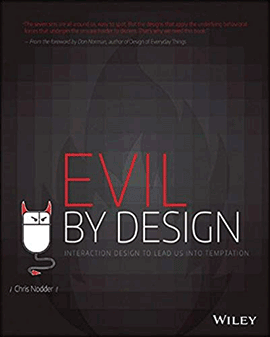Book Specifications
Title: Evil by Design: Interaction Design to Lead Us into Temptation
Author: Chris Nodder
Formats: Paperback, Kindle
Publisher: Wiley
Published: 2013, 1st edition
Pages: 320
ISBN-10: 1118422147
ISBN-13: 978-1118422144
The Seven Deadly Sins as an Organizing Scheme
What happens when we use the seven deadly sins—lust, gluttony, greed, sloth, wrath, envy, and pride—as a closed classification system for persuasive patterns in experience design? The most obvious outcome is that you get an interesting book title!
Some of the deadly sins are easier to apply than others. Consider sloth, which assumes that people are generally lazy and tend to give up if a low- to moderate-cost task seems too difficult. While most firms make it very easy for a Web-site visitor to convert and become a paying customer, some take the opposite approach if customers decide they want to cancel their service. In such cases, a customer would likely have a hard time finding information on how to cancel, and once he does, he’ll probably have to switch channels, call the company, and wait on hold for a considerable amount of time, then explain to a customer-service agent—who is trained to retain customers—that he wants to cancel the service. In the words of Nodder, “Offer subsequent opt-out of the service, but require users to perform a difficult task—completing and mailing in a paper form, for instance—to opt out. This leads to large cancellation abandonment rates.”
Good UX design removes any difficulties that customers may have in converting, or undertaking activities that a Web site owner would like them to do. The goals of the user and experience owner are aligned. However, evil UX design takes advantage of the user and prioritizes a Web site owner’s goals at the expense of the user’s, seeing ease of use as a fig leaf that conceals the real goal: conversion regardless of whether the user is an informed participant.
Rather than appealing to the user through the benefits of achieving a given outcome, the persuasive patterns this book presents appeal to weaknesses in the human character.
Putting Evil to Work
Nodder’s method for presenting these patterns is helpful. He starts each section by describing the vice in question, provides examples of where it has been exploited, includes callouts that succinctly describe the pattern, and follows up with a how-to section, providing specific actions that a designer can take to develop a persuasive experience.
The section on gluttony, for example, provides an overview of the vice, but also gives more insight into how to encourage gluttony. One sure-fire way is to make people feel entitled to a reward. You can do this by making customers put in some amount of effort to earn an exclusive reward. Nodder goes on to provide advice on how to present a reward, including what language to use and manipulating its perceived value.
One of the joys of reading the book was finding out how these persuasive patterns permeate my daily life. Gluttony in particular is identifiable in airline miles, video-game point systems, and pretty much any loyalty program. Not only does the book define user-interface patterns, it offers insights into how we could use these persuasive techniques more broadly—for example, in the creation of a business strategy.
 Lucifer. Darth Vader. Voldemort. Gru. Literature is filled with heroes, but also memorable villains. And why not? The uncomfortable truth is that, for many of us, villains and evil are much more interesting than heroes and good. It’s easy to identify the hero—the good—in a narrative. Heroes are predictable and idealistic. Villainy, on the other hand, leads us to ask questions: Why? What next? Can evil tactics get more results than good ones?
Lucifer. Darth Vader. Voldemort. Gru. Literature is filled with heroes, but also memorable villains. And why not? The uncomfortable truth is that, for many of us, villains and evil are much more interesting than heroes and good. It’s easy to identify the hero—the good—in a narrative. Heroes are predictable and idealistic. Villainy, on the other hand, leads us to ask questions: Why? What next? Can evil tactics get more results than good ones?